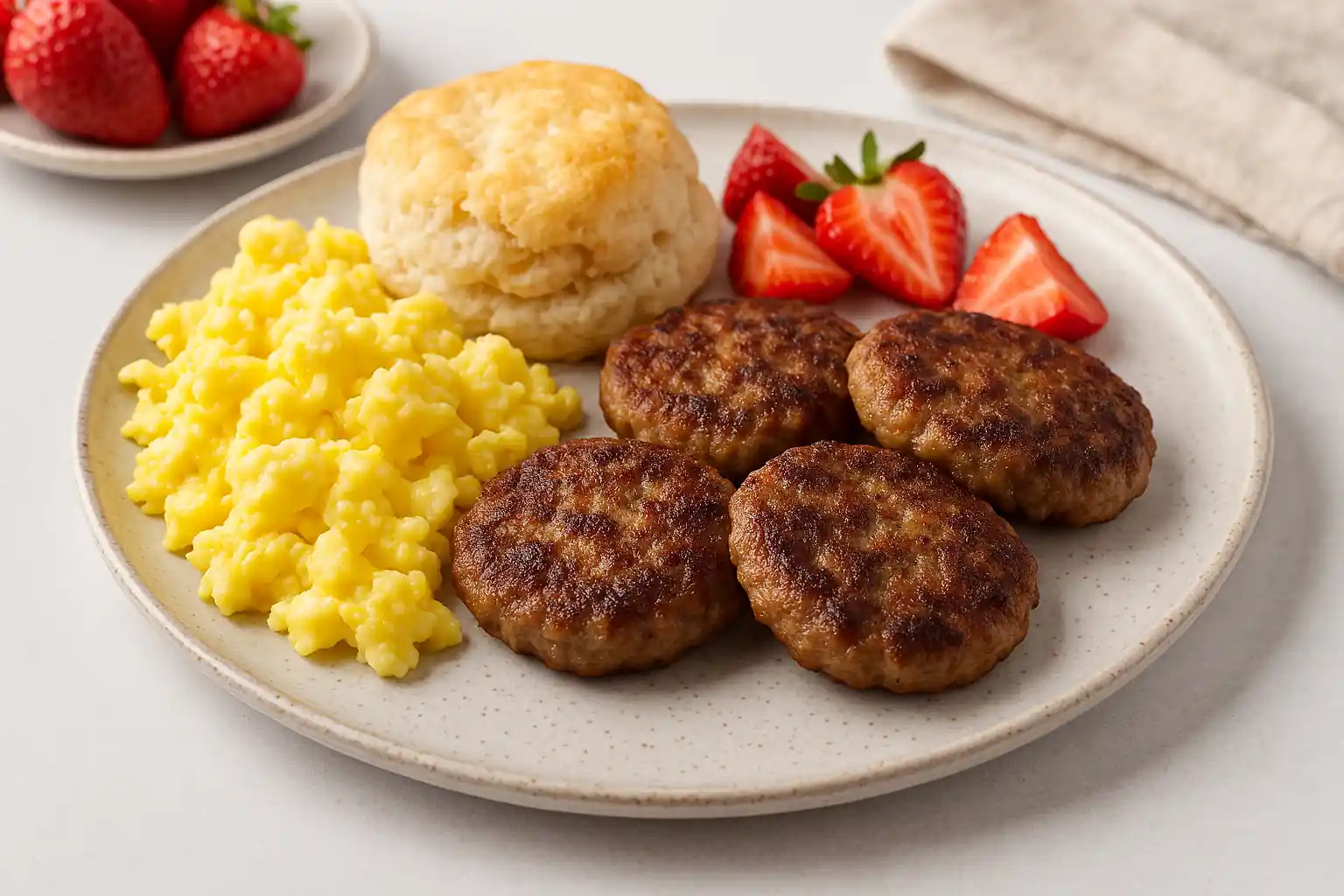Jimmy Dean Breakfast Sausage Seasoning Recipe
The comfort of a warm, hearty breakfast often begins with the sizzle of sausage in a skillet. For many Americans, Jimmy Dean breakfast sausage holds a nostalgic place on the plate. Whether tucked into a biscuit, crumbled in a casserole, or paired with scrambled eggs, this flavorful pork sausage is a staple in many homes.
In this guide, we will explore everything you need to know about making a copycat Jimmy Dean breakfast sausage recipe. From understanding the blend of seasonings and types of pork to learning how to form sausage into patties, grind meat properly, and even freeze or reheat leftovers — this is your one-stop source for sausage mastery.
What Is Breakfast Sausage?
Breakfast sausage refers to a ground meat blend — usually pork — seasoned with a unique mix of spices. These are often shaped into patties or links and cooked until browned and crispy. The American-style sausage typically includes herbs like sage and thyme, which differentiate it from other pork sausages such as Italian or bratwurst.
The Rise of Jimmy Dean Breakfast Sausage
Jimmy Dean, a brand launched by country singer Jimmy Dean in 1969, popularized this form of savory morning meat. Known for its distinct sage-forward seasoning and tender texture, Jimmy Dean sausage soon became a household name.
The Ingredients That Define the Jimmy Dean Sausage Flavor
To successfully replicate this sausage recipe at home, you need to understand the sausage spice components that give Jimmy Dean its trademark taste.
Core Components of the Seasoning Mix
-
Ground pork – the base of the sausage.
-
Sage – the leading flavor note.
-
Black pepper – adds depth and mild heat.
-
Crushed red pepper or red pepper flakes – optional for heat.
-
Thyme and parsley – enhance the herbaceous profile.
-
Nutmeg – provides warmth.
-
Brown sugar or maple syrup – adds sweet balance.
-
Salt – binds the flavors.
-
MSG (monosodium glutamate) – found in some store-bought versions for umami, but optional in homemade versions.
You can explore more about common sausage spices on University of Georgia’s meat science extension.
How to Make Copycat Jimmy Dean Breakfast Sausage at Home
Making homemade breakfast sausage means you control the flavor, fat content, and portion size.
Tools You’ll Need
-
Large bowl – for mixing the seasoned meat.
-
Meat grinder (if starting from whole cuts).
-
Skillet – preferably cast iron for browning.
-
Airtight container – for storing leftovers.
-
Baking sheet – to freeze patties before bagging.
Step-by-Step Recipe
Ingredients
-
2 pounds ground pork
-
2 tsp dried sage
-
1 tsp black pepper
-
½ tsp crushed red pepper
-
1 tsp thyme
-
1 tsp parsley
-
½ tsp nutmeg
-
1 tbsp maple syrup or 2 tsp brown sugar
-
1½ tsp salt
-
Optional: ½ tsp MSG (for authentic supermarket-style flavor)
Instructions
-
Mix the ingredients: In a large bowl, combine ground pork and all seasonings. Mix well until everything is evenly distributed.
-
Shape the sausage patties: Form the seasoned meat into small rounds, about 3 inches wide and ½ inch thick.
-
Refrigerate: Let the patties rest for 30 minutes to allow the spices to infuse.
-
Cook the sausage: Heat a skillet over medium heat. Cook each patty for 4–5 minutes per side or until browned and cooked through.
Learn how to handle raw pork and food safety guidelines from the USDA Food Safety and Inspection Service.
Flavor Variations to Make This Recipe Unique
While the original recipe is tried and true, here are ways to make a savory or sweet and savory twist:
Maple Sausage
Substitute maple syrup for the brown sugar and reduce red pepper for a sweeter taste.
Spicy Sausage
Increase crushed red pepper and add a pinch of cayenne.
Herbaceous Sausage
Use fresh herbs like thyme, sage, and parsley for an earthy finish.
You can study how spice blends affect meat profiles in culinary traditions from The Culinary Institute of America.
The Science Behind Grinding Meat for Sausage
The grind size can influence the texture and cooking performance of sausage. A coarse grind gives a hearty bite, while a fine grind produces a more cohesive patty.
For a detailed look at grind techniques and fat content balance, refer to Oklahoma State University’s meat processing guides.
How to Freeze and Store Homemade Breakfast Sausage
Freezing homemade sausage properly can help preserve flavor and texture for up to three months.
Step-by-Step Freezing Process
-
Form patties and place them on a parchment-lined baking sheet in a single layer.
-
Freeze uncovered for 2–3 hours until solid.
-
Transfer to an airtight container or freezer-safe bag. Label with the date and type (e.g., maple, spicy).
-
Store flat in the freezer to save space.
This method prevents freezer burn and makes it easy to pull out just what you need.
You can explore freezer safety and methods for preserving meat from Penn State Extension.
Reheating and Cooking Frozen Sausage Patties
How to Reheat Frozen Sausage
You can cook sausage patties from frozen or thaw them overnight in the refrigerator.
-
Skillet over medium heat: Cook for 6–7 minutes per side until internal temperature reaches 160°F.
-
Microwave: Use defrost mode, then brown in a skillet for crispiness.
-
Oven method: Place on a sheet pan at 350°F for 15–20 minutes.
Refer to Oregon State University Extension for safe meat reheating practices.
Homemade vs. Store-Bought Jimmy Dean Sausage
Many people wonder how homemade breakfast sausage compares to the store-bought Jimmy Dean sausage.
Nutritional Differences
| Feature | Homemade | Store-Bought |
|---|---|---|
| Preservatives | None | Contains MSG, sodium nitrate |
| Fat control | Adjustable | Usually ~30% fat |
| Flavor customization | Fully customizable | Fixed |
| Sweeteners | Natural (e.g., maple syrup) | Often contains high-fructose corn syrup |
You can learn more about food additives such as monosodium glutamate on Harvard T.H. Chan School of Public Health.
Alternative Meats: Ground Turkey and Other Options
Not everyone prefers pork. Here’s how to substitute:
Ground Turkey
-
Use lean ground turkey (85/15) for similar texture.
-
Add 1 tablespoon olive oil for moisture.
-
Increase herbs to compensate for milder taste.
Other Meats
-
Chicken sausage: Lighter flavor, requires strong spices.
-
Beef sausage: Richer and firmer, less common for breakfast but flavorful.
You can read about healthy protein swaps on Mayo Clinic’s nutrition pages.
Recipes That Use Homemade Sausage
Homemade sausage is incredibly versatile in cooking beyond just frying patties.
Breakfast Sandwiches
Layer your sausage patties with hash browns, scrambled eggs, and cheese in a biscuit or pancake.
Sausage Gravy
Crumble your sausage in a skillet, add flour and milk for a classic Southern gravy over biscuits.
Sausage Casserole
Mix sausage with eggs, cheese, and bread cubes for a hearty breakfast casserole. Freeze portions for later use.
You can find top-rated sausage-based dishes on Allrecipes.
Doubling or Tripling the Recipe for Batch Cooking
Scaling Up the Recipe
-
2 lbs pork = ~10 patties
-
4 lbs pork = ~20 patties
-
6 lbs pork = ~30 patties
When doubling or tripling, measure spices carefully and mix in batches for consistency.
Storage Tips
-
Freeze cooked patties for quick meals.
-
Refrigerate uncooked patties up to 3 days in an airtight container.
For tips on bulk cooking and kitchen safety, refer to North Dakota State University Extension.
Sausage Spice Balance: What If It Tastes Off?
If your seasoning doesn’t match the classic Jimmy Dean breakfast sausage flavor, here are common reasons:
Too Bland
-
Increase sage and black pepper.
-
Add a small amount of MSG or brown sugar.
Too Sweet
-
Reduce maple syrup or use only savory herbs.
Too Spicy
-
Omit crushed red pepper.
-
Add more ground pork to dilute the heat.
Explore spice ratios in sausage from Iowa State University Extension.
Clone Recipes and Culinary Science Behind Jimmy Dean Sausage
Many culinary enthusiasts have tried to replicate the original recipe for Jimmy Dean clones. These copycat sausage recipes rely on culinary science to mimic flavor, moisture, and texture.
Key Tips to Clone Jimmy Dean Breakfast Sausage
-
Use a 70/30 meat-to-fat pork blend.
-
Include sweet elements like maple or brown sugar.
-
Mix meat and seasoning thoroughly, but don’t overwork it.
-
Chill meat before forming into bulk sausage or sausage patties.
You can learn how meat behaves during seasoning and cooking from Clemson University’s meat science resources.
Warm up with our Hot Cocoa Mix Recipe Without Dry Milk — Homemade Hot Chocolate Guide for a rich, cozy drink made easy at home.
Frequently Asked Questions (FAQs)
Can I make this recipe without pork?
Yes, you can substitute ground turkey or chicken and increase the seasoning for flavor.
What’s the best way to cook sausage patties?
Use a skillet over medium heat and cook 4–5 minutes per side until crispy and browned.
Can I add other spices?
Absolutely. Try garlic powder, smoked paprika, or even a hint of cayenne.
How do I store leftover sausage?
Use an airtight container in the fridge for 3–4 days, or freeze for up to 3 months.
Final Thoughts: Why You Should Make This Recipe at Home
Making a Jimmy Dean breakfast sausage recipe at home gives you:
-
Full control over fat, spice, and sweeteners.
-
A chance to avoid MSG or artificial additives.
-
A flavorful, authentic copycat you can tweak to your liking.
-
The joy of turning seasoned meat into something delicious.
Whether you’re preparing for a busy weekday breakfast or creating a hearty weekend brunch, this recipe is a top-rated choice that rivals the supermarket version.
For more on food cloning and recipe development, visit Utah State University Extension.

